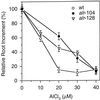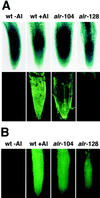Aluminum-resistant Arabidopsis mutants that exhibit altered patterns of aluminum accumulation and organic acid release from roots
- PMID: 9576769
- PMCID: PMC35025
- DOI: 10.1104/pp.117.1.9
Aluminum-resistant Arabidopsis mutants that exhibit altered patterns of aluminum accumulation and organic acid release from roots
Abstract
Al-resistant (alr) mutants of Arabidopsis thaliana were isolated and characterized to gain a better understanding of the genetic and physiological mechanisms of Al resistance. alr mutants were identified on the basis of enhanced root growth in the presence of levels of Al that strongly inhibited root growth in wild-type seedlings. Genetic analysis of the alr mutants showed that Al resistance was semidominant, and chromosome mapping of the mutants with microsatellite and random amplified polymorphic DNA markers indicated that the mutants mapped to two sites in the Arabidopsis genome: one locus on chromosome 1 (alr-108, alr-128, alr-131, and alr-139) and another on chromosome 4 (alr-104). Al accumulation in roots of mutant seedlings was studied by staining with the fluorescent Al-indicator dye morin and quantified via inductively coupled argon plasma mass spectrometry. It was found that the alr mutants accumulated lower levels of Al in the root tips compared with wild type. The possibility that the mutants released Al-chelating organic acids was examined. The mutants that mapped together on chromosome 1 released greater amounts of citrate or malate (as well as pyruvate) compared with wild type, suggesting that Al exclusion from roots of these alr mutants results from enhanced organic acid exudation. Roots of alr-104, on the other hand, did not exhibit increased release of malate or citrate, but did alkalinize the rhizosphere to a greater extent than wild-type roots. A detailed examination of Al resistance in this mutant is described in an accompanying paper (J. Degenhardt, P.B. Larsen, S.H. Howell, L. V. Kochian [1998] Plant Physiol 117: 19-27).
Figures



Similar articles
-
Aluminum resistance in the Arabidopsis mutant alr-104 is caused by an aluminum-induced increase in rhizosphere pH.Plant Physiol. 1998 May;117(1):19-27. doi: 10.1104/pp.117.1.19. Plant Physiol. 1998. PMID: 9576770 Free PMC article.
-
A promoter-swap strategy between the AtALMT and AtMATE genes increased Arabidopsis aluminum resistance and improved carbon-use efficiency for aluminum resistance.Plant J. 2012 Jul;71(2):327-37. doi: 10.1111/j.1365-313X.2012.04994.x. Epub 2012 May 22. Plant J. 2012. PMID: 22413742
-
Aluminum-activated citrate and malate transporters from the MATE and ALMT families function independently to confer Arabidopsis aluminum tolerance.Plant J. 2009 Feb;57(3):389-99. doi: 10.1111/j.1365-313X.2008.03696.x. Epub 2008 Oct 30. Plant J. 2009. PMID: 18826429
-
Recent progress in the research of external Al detoxification in higher plants: a minireview.J Inorg Biochem. 2003 Sep 15;97(1):46-51. doi: 10.1016/s0162-0134(03)00245-9. J Inorg Biochem. 2003. PMID: 14507459 Review.
-
[Organic acid secretion and its detoxification mechanism in plant roots under aluminum stress].Zhi Wu Sheng Li Yu Fen Zi Sheng Wu Xue Xue Bao. 2005 Apr;31(2):111-8. Zhi Wu Sheng Li Yu Fen Zi Sheng Wu Xue Xue Bao. 2005. PMID: 15840928 Review. Chinese.
Cited by
-
One novel mitochondrial citrate synthase from Oryza sativa L. can enhance aluminum tolerance in transgenic tobacco.Mol Biotechnol. 2009 Jul;42(3):299-305. doi: 10.1007/s12033-009-9162-z. Epub 2009 Mar 27. Mol Biotechnol. 2009. PMID: 19326262
-
Interactive effects of phosphorus fertilization and salinity on plant growth, phosphorus and sodium status, and tartrate exudation by roots of two alfalfa cultivars.Ann Bot. 2022 Jan 8;129(1):53-64. doi: 10.1093/aob/mcab124. Ann Bot. 2022. PMID: 34582551 Free PMC article.
-
Coordination between apoplastic and symplastic detoxification confers plant aluminum resistance.Plant Physiol. 2013 Aug;162(4):1947-55. doi: 10.1104/pp.113.219147. Epub 2013 Jun 17. Plant Physiol. 2013. PMID: 23776189 Free PMC article.
-
Differential Al resistance and citrate secretion in barley (Hordeum vulgare L.).Planta. 2003 Sep;217(5):794-800. doi: 10.1007/s00425-003-1043-2. Epub 2003 May 7. Planta. 2003. PMID: 12734756
-
Aluminum accumulation at nuclei of cells in the root tip. Fluorescence detection using lumogallion and confocal laser scanning microscopy.Plant Physiol. 2000 Jun;123(2):543-52. doi: 10.1104/pp.123.2.543. Plant Physiol. 2000. PMID: 10859184 Free PMC article.
References
-
- Aniol A. Genetics of tolerance to aluminum in wheat (Triticumaestivum L. Thell) Plant Soil. 1990;123:223–227.
-
- Basu U, Godbold D, Taylor GJ. Aluminum resistance in Triticum aestivum associated with enhanced exudation of malate. J Plant Physiol. 1994;144:747–753.
-
- Bell CJ, Ecker JR. Assignment of 30 microsatellite loci to the linkage map of Arabidopsis. Genomics. 1994;19:137–144. - PubMed
-
- Carver BF, Ownby JD. Acid soil tolerance in wheat. Adv Agron. 1995;54:117–173.
Publication types
MeSH terms
Substances
LinkOut - more resources
Full Text Sources
Other Literature Sources
Molecular Biology Databases
Miscellaneous

